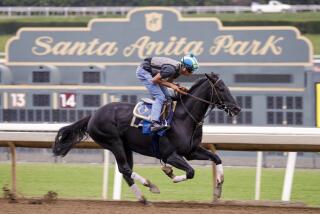Track Director Switches Gears
- Share via
KNOXVILLE, Iowa — Ralph Capitani’s greatest ambition was to coach football at Notre Dame. Instead, he found himself at the citadel of a far different sport.
Capitani is race director at the Knoxville Raceway, where every August fans from across the country gather by the thousands to camp in front yards and church parking lots, chow down on grilled meats and home-baked goodies and watch the biggest, most lucrative event in sprint car racing -- the Knoxville Nationals.
You could say this 72-year-old former football star has, well, switched gears -- and quite smoothly.
“I had the philosophy that anybody who would be connected to a race car had to be an idiot,” said Capitani, who watches over this week’s 44th Nationals. “I was not brought up in racing at all.”
Then he found that a summer job as the track’s secretary in 1967 paid a lot better than the one he had running the city’s swimming pool. Twelve years later, he became the track’s race director and that evolved into his sole job in 1992, when he retired as a teacher at Knoxville High School.
“I guess I fell in love with it or I would not be here,” Capitani said with a grin.
The man everyone calls “Cappy” has embraced the job to such an extent that earlier this year he was voted the most influential person in sprint car racing in the annual North American Sprint Car Poll of manufacturers, media members, sanctioning officials and promoters.
During Capitani’s 37 years at the track, the Nationals have grown from a race that had 5,000 seats and drew drivers almost exclusively from the Midwest to a major event that attracts a crowd of 30,000 for the Saturday night finals and drivers from as far away as Australia.
The winner of the 30-lap feature gets $125,000 from a purse of almost $800,000.
Service clubs and churches in the town of 7,700 get involved by running food booths and other amenities for visitors. The booths are the biggest fund-raisers of the year for organizations such as Rotary and Lions.
While helping set the tone in the growth of the Nationals, Capitani has overseen a major expansion in the track’s weekly programs.
The half-mile dirt oval used to hold races only in the summer. Now the sprint car schedule runs from mid-April to October, drawing about 75 cars at a time. Unafraid to try something new, Capitani has scheduled a first for the track in October -- a national race for late-model stocks.
Mixing with drivers, car owners and racing fans certainly wasn’t what Capitani envisioned in his younger days. As a football player at Northern Iowa, then known as Iowa State Teachers College, he ran and passed well enough to attract the attention of NFL teams, most notably the Chicago Bears.
“They wanted me to come to their tryout camp, but unfortunately I got another letter from the United States government and I went into the service,” Capitani said. “I played ball in the service, but I laid out one year and that second year I played in Germany, I hurt so bad I decided I can’t play this game anymore.”
He still wanted to coach it, though. His goal: Notre Dame, the domain of Rockne and Leahy and the Four Horsemen.
“I probably had that dream until I came down here and started raising a family and decided hey, this was kind of a nice place to raise our family,” Capitani said. “So we’ve been here ever since.”
For all the fun, though, it is a work.
And, it seems, still enjoying every minute, especially when Nationals week comes around.
“There’s always a great deal of anticipation for the Nationals,” Capitani said. “But when it’s over, it’s like taking a school bus off your back.”
No wonder. Sprint car racing is big business. The top World of Outlaws drivers have hundreds of thousands of dollars invested in their efforts. They take their racing seriously. They expect well organized events and a fast, safe track.
The reward for Capitani comes from seeing fans cheer their favorite driver and then swarm the infield by the hundreds after the races to get autographs and visit with the crews.
“”The challenge is to get people here just once and I think they’ll be back,” Capitani said. I’ve always said if they come three times, they’re in for life.”
Just like Capitani.
More to Read
Go beyond the scoreboard
Get the latest on L.A.'s teams in the daily Sports Report newsletter.
You may occasionally receive promotional content from the Los Angeles Times.










